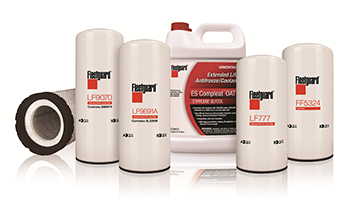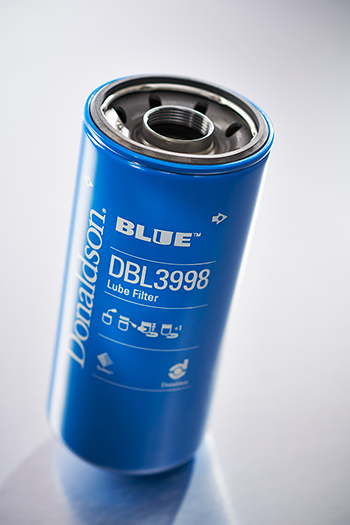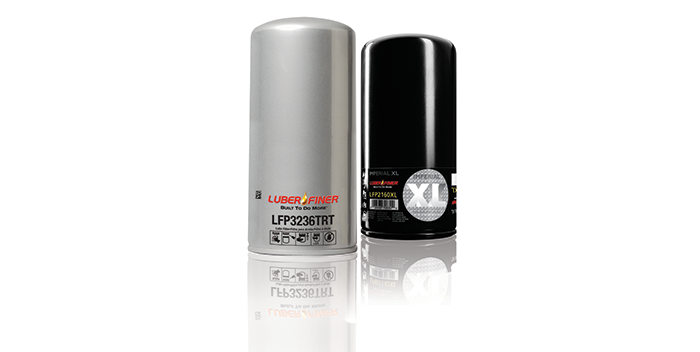Engines have evolved. Today’s diesel engines are more complex and efficient than ever before. With great evolution comes great components, and engine lubrication filtration has kept pace with engine technology.
“Engine technology has evolved over the years, especially since the introduction of selective catalytic reduction [SCR]. The SCR system allows for more efficient combustion, a cleaner burn and much improved fuel efficiency—this means less contamination in the oil. Oils have improved too, they can handle more contaminants, holding them in suspension longer,” explains Russ Bretell, training and technical sales manager for Cummins Filtration. “Our filters have evolved as well, meeting today and future engine’s filtration needs. The use of advanced synthetics has tremendously improved our filter performance in all the areas that matter. And that’s in efficiency—the size of the contaminant to be removed, capacity, the amount of contaminant it can hold (and how long it can last) and its ability to flow oil even when it’s thicker due to temperature, cold starts or due to high contamination and oxidation.”
Clean oil is the key to keeping your fleet’s engines running smoothly. You want to keep it as pristine as possible, and that comes down to choosing the proper filtration for your fleet application.
“Oil is the life blood of a diesel engine and it should be treated as such. There are many avenues for contaminant to reach the oil and some of them occur before the first engine start after maintenance is complete,” says John Gaither, director of heavy-duty design engineering for Luber-finer, which offers a complete line of heavy-duty oil filters, fuel, intake air, cabin air, coolant, hydraulic and transmission filters plus specialty diesel fuel dispensing filters and by-pass filter housings and elements. “Name brand oil and filter suppliers have your best interest in mind. Stick with proven brands and protect your investment.”
 Beyond the brand, spec’ing the proper filter often comes down to the filter rating, of which there are two commonly accepted media ratings—a nominal micron rating and an absolute micron rating. A nominal rating usually means the filter’s media can capture a given percentage of particles of a stated size, whereas an absolute rating is often expressed in the form of a percentage of each size of particles captured. Your application will determine the proper filter rating for your trucks.
Beyond the brand, spec’ing the proper filter often comes down to the filter rating, of which there are two commonly accepted media ratings—a nominal micron rating and an absolute micron rating. A nominal rating usually means the filter’s media can capture a given percentage of particles of a stated size, whereas an absolute rating is often expressed in the form of a percentage of each size of particles captured. Your application will determine the proper filter rating for your trucks.
“Understanding the engine condition, how and where you drive, and when you want to change the oil and filter are the first steps in specifying an appropriate oil filter,” says Edward Covington, vice president of global quality for Wix Filters, which offers filters for heavy-duty applications that are designed to withstand the operating environment and the way the truck is driven. “For instance, an older engine may produce more soot and premature oil break byproducts that may need longer filter life. Equipment operating in extremely dusty or abrasive environments may need a higher level of efficiency. Filters operating in extreme duty or harsh environments may need different constructions.”
On top of the ratings, there is also beta (β) ratio testing that yields readily comparable test results for real world applications. Even with all the ratings and testing, the filtration choice can get murky.
“Absolute micron ratings are the only way to truly compare apples to apples, and beta ratios are the only way to compare actual filtration performance. However, they are only addressing one thing and that’s a filter’s efficiency at a given micron size,” Bretell explains. “For fuel filtration, beta ratios give actual filtration ability, however, we also need to look at the filter’s flow characteristics, which relates to contaminant capacity, or filter life, and more importantly, water removal ability. For lube filtration, the efficiency, capacity and cold flow performance, which is the ability to flow oil, even when it’s thicker due to cold weather or due to high levels of contamination and oxidation. It’s the balance of these factors that truly indicates effective filtration performance.”
While engines theoretically all perform the same job, the way in which they accomplish it is vastly different. Each fleet has its own engine makeup and duty cycles, which means that working with your supplier is the best way to find the filter choices that fits your fleet.
“In order to provide protection to the engine and maintain today’s higher oil cleanliness standards, lube filters capture wear metals, soot and contaminants from the engine oil,” says Veli Kalayci, manager of engine liquid products for Donaldson, which offers a wide range of engine lube oil filters to cover the needs of light-, medium- and heavy-duty on-road vehicles, including its recently released Donaldson Blue lube oil filters. “Working with a reputable filtration supplier and utilizing an oil analysis program is the best way a fleet can ensure they have the proper filtration in place to meet the demands of their fleet.”
Extending drains
 Getting the most out of engine oil is a top priority for fleets. Anytime you talk about engine lubricant, extended oil drains is always a point of interest. It’s a delicate balancing act between the expected oil life efficiency and proper engine protection.
Getting the most out of engine oil is a top priority for fleets. Anytime you talk about engine lubricant, extended oil drains is always a point of interest. It’s a delicate balancing act between the expected oil life efficiency and proper engine protection.
Over time, acids in the oil build up. This is a result of the combustion process and the heat generated. The total base number (TBN) of the oil refers to the amount of acid control the oil has, Cummins Filtration’s Bretell explains. When the TBN is depleted, the ability to control these acids diminishes, and the acids can cause corrosive wear in the engine. Oil companies have specific recommendations on when the TBN is at the point when the oil needs to be changed, as they are the experts on their own products.
“Another factor to consider is the increase over time of soot,” he continues. “While the oil does have soot dispersants to manage this increase, there comes a time when the limit is reached. Excessive soot can cause thicker oil and abrasive wear. Of course, using premium filtration products that are designed for these extended applications is a must.”
With that, in addition to your duty-cycle and application, in mind, most agree that fleets should feel safe performing extended oil drains as long as there’s an oil analysis program in place to ensure that the oil effective life isn’t being pushed beyond its limits.
“In order to place a new piece of equipment into an extended drain program a baseline must be established; that baseline should be created by oil sampling several times through the normal change interval and reviewing the results prior to going past the OE recommended interval,” Luber-finer’s Gaither says. With proper oil analysis an extended drain program will never be detrimental.”
Gaither went on to stress the importance of doing an oil analysis and repeated that any fleet should not do an extended drain without doing an oil analysis.
Donaldson’s Kalayci echoes that sentiment, adding: “My recommendation is that if the fleets choose to extend oil drain intervals, they should start by doing so carefully and incrementally, by conducting oil analysis at each newly extended interval and inspecting filters for any signs of issues. Work with your oil and filter supplier to analyze and draw conclusions from the data captured. Fleets may want to involve the OEM if drain interval is extended by a factor of two or more.”
The idea is not to push your oil to its limits, but to ensure that your drain intervals are meeting the expected oil life. Wix’s Covington points out that without the proper analysis, a fleet’s drain interval can already be past the oil’s effective life.
“To some, ‘extend’ may mean going longer than one should. We suggest fleets focus on ‘effective’ oil and filter change intervals for the specific engine and how you drive rather than focusing on an ‘extended’ drain,” he says. “No two circumstances are the same. Fluid analysis is an excellent way to determine an effective drain period for the oil, filter, engine and operating environment combination. Fluid analysis can help make an informed decision about appropriate and effective drain intervals.”
It’s clear that, as with most fleet equipment operations, you don’t truly know your equipment’s—or in this case, oil’s—effectiveness until you test and monitor.
 Not passing by by-pass filters
Not passing by by-pass filters
By definition, by-pass filters filter a small amount of fluid in a by-pass loop that is returned to sump after the oil is filtered. These generally are used to remove excessive soot and other oil breakdown contaminants, explains Edward Covington, vice president of global quality for Wix Filters.
“In modern engines, by-pass filters are in addition to the primary full flow filters. These can be separate from or integrated into a full flow combination filter,” he says. “Some engine designs and oil specifications do not require bypass filtration, while others do.”
“By-pass filters take a small portion of the oil pump output and directs it through a high efficiency filter before returning it to the oil pan,” says John Gaither, PE, director of heavy-duty design engineering for Luber-finer. “A true by-pass filter needs this low pressure return loop in order to have sufficient differential pressure to operate properly.”
If the engine is equipped with a by-pass filter, it is necessary to service that filter on an effective and recommended interval.














